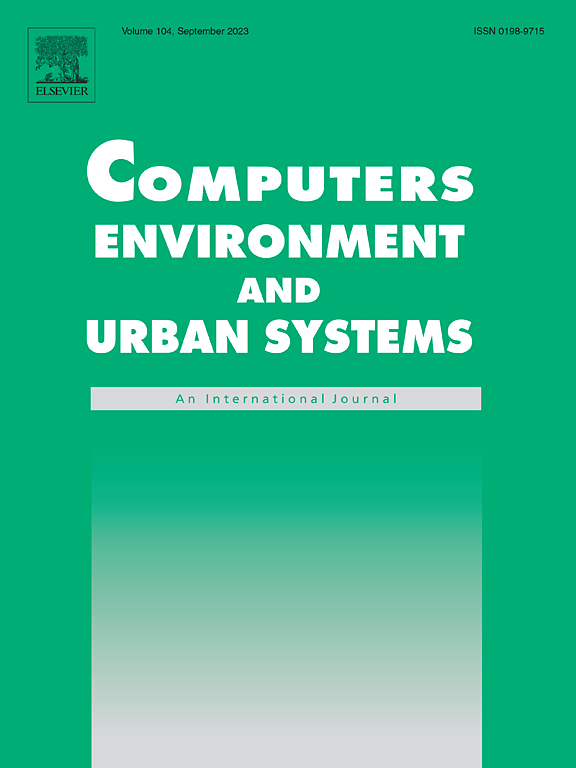Spatiotemporal dynamics of ethnoracial diversity and segregation in Los Angeles County: Insights from mobile phone data
IF 8.3
1区 地球科学
Q1 ENVIRONMENTAL STUDIES
Computers Environment and Urban Systems
Pub Date : 2024-10-30
DOI:10.1016/j.compenvurbsys.2024.102203
引用次数: 0
Abstract
Ethnoracial segregation persists as a pressing issue in American cities. Understanding these issues is crucial for promoting social equity and justice, and planning more inclusive cities. Prior research has predominantly emphasized residential ethnoracial diversity but has often overlooked or inadequately addressed ethnoracial diversity and segregation in individuals' daily activities and places they visit, due in part to data limitations. This study leverages a dynamic measure of ethnoracial diversity and dominance at the finest spatial scale, specifically at the Points of Interest (POI) level and various temporal contexts. Using one month of privacy-enhanced mobile phone location data in Los Angeles County, California, this study explores ethnoracial diversity and spatial segregation simultaneously in POI visits in LA County. Our findings confirm that individuals' daily mobility in urban areas enhances ethnoracial mixing at activity locations. Empirical results indicate that the diversity of visitors to a POI is significantly higher than the neighborhood diversity where the same POI is located. A significant positive linear relationship was found between the neighborhood diversity of POIs and the diversity of visitors. About 34 % of the variance in the diversity of visitors to POIs can be explained by the neighborhood diversity of POIs. Our results also suggest significant spatial clusters of isolated/integrated areas regarding ethnoracial mixing in people's daily activity locations. Notably, the Hispanic or Latino population tends to stay in their own communities and experiences a higher level of segregation in their daily activity locations. The findings have significant implications for urban planners and policymakers to design targeted solutions and policies to promote social equity, integration, and equal access to public amenities and opportunities in urban spaces.
洛杉矶县种族多样性和种族隔离的时空动态:手机数据的启示
种族隔离一直是美国城市的一个紧迫问题。了解这些问题对于促进社会公平和正义以及规划更具包容性的城市至关重要。以往的研究主要强调居住地的人种多样性,但往往忽略了个人日常活动和访问场所的人种多样性和种族隔离问题,或对其关注不够,部分原因在于数据的局限性。本研究在最精细的空间尺度上,特别是在兴趣点(POI)层面和各种时间背景下,对种族多样性和优势进行了动态测量。本研究利用加利福尼亚州洛杉矶县一个月的隐私增强型手机定位数据,同时探讨了洛杉矶县兴趣点访问中的人种多样性和空间隔离问题。我们的研究结果证实,个人在城市地区的日常流动增强了活动地点的人种混合。实证结果表明,一个主要景点的游客多样性明显高于同一主要景点所在社区的多样性。研究发现,主要景点的邻里多样性与游客多样性之间存在明显的正线性关系。POI 附近的多样性可以解释 POI 访客多样性中约 34% 的差异。我们的研究结果还表明,在人们日常活动地点的人种混合方面,存在着明显的孤立/融合区域空间集群。值得注意的是,西班牙裔或拉丁裔人口倾向于留在自己的社区,他们的日常活动地点的隔离程度较高。这些发现对城市规划者和决策者设计有针对性的解决方案和政策,以促进社会公平、融合以及平等享有城市空间的公共设施和机会具有重要意义。
本文章由计算机程序翻译,如有差异,请以英文原文为准。
求助全文
约1分钟内获得全文
求助全文
来源期刊

Computers Environment and Urban Systems
Multiple-
CiteScore
13.30
自引率
7.40%
发文量
111
审稿时长
32 days
期刊介绍:
Computers, Environment and Urban Systemsis an interdisciplinary journal publishing cutting-edge and innovative computer-based research on environmental and urban systems, that privileges the geospatial perspective. The journal welcomes original high quality scholarship of a theoretical, applied or technological nature, and provides a stimulating presentation of perspectives, research developments, overviews of important new technologies and uses of major computational, information-based, and visualization innovations. Applied and theoretical contributions demonstrate the scope of computer-based analysis fostering a better understanding of environmental and urban systems, their spatial scope and their dynamics.
 求助内容:
求助内容: 应助结果提醒方式:
应助结果提醒方式:


